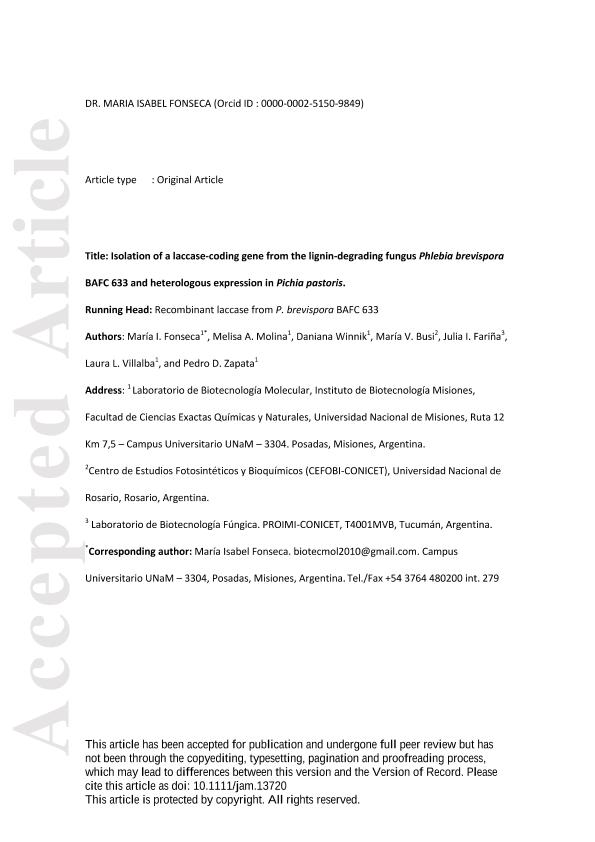Mostrar el registro sencillo del ítem
dc.contributor.author
Fonseca, Maria Isabel

dc.contributor.author
Molina, Melisa Antonella

dc.contributor.author
Winnik, D. L.
dc.contributor.author
Busi, María Victoria

dc.contributor.author
Fariña, Julia Ines

dc.contributor.author
Villalba, Laura

dc.contributor.author
Zapata, Pedro Dario

dc.date.available
2019-10-18T18:33:55Z
dc.date.issued
2018-06
dc.identifier.citation
Fonseca, Maria Isabel; Molina, Melisa Antonella; Winnik, D. L.; Busi, María Victoria; Fariña, Julia Ines; et al.; Isolation of a laccase-coding gene from the lignin-degrading fungus Phlebia brevispora BAFC 633 and heterologous expression in Pichia pastoris; Wiley Blackwell Publishing, Inc; Journal of Applied Microbiology; 124; 6; 6-2018; 1454-1468
dc.identifier.issn
1364-5072
dc.identifier.uri
http://hdl.handle.net/11336/86423
dc.description.abstract
Aims: Isolate and characterize a laccase-encoding gene (lac I) of Phlebia brevispora BAFC 633, as well as cloning and expressing cDNA of lac I in Pichia pastoris. And to obtain a purified and characterized recombinant laccase to analyse the biotechnological application potential. Methods and Results: Lac I was cloned and sequenced, it contains 2447 pb obtained by PCR and long-distance inverse PCR. Upstream of the structural region of the laccase gene, response elements such as metals, antioxidants, copper, nitrogen and heat shock were found. The coding region consisted of a 1563-pb ORF encoding 521 amino acids. Lac I was functionally expressed in P. pastoris and it was shown that the gene cloned using the α-factor signal peptide was more efficient than the native signal sequence, in directing the secretion of the recombinant protein. Km and highest kcat/Km values towards ABTS, followed by 2,6-dimethylphenol, were similar to other laccases. Lac I showed tolerance to NaCl and solvents, and nine synthetic dyes could be degraded to different degrees. Conclusions: Lac I-encoding gene could be successfully sequenced having cis-acting elements located at the regulatory region. It was found that lac I cDNA expressed in P. pastoris using the α-factor signal peptide was more efficient than the native signal sequence. The purified Lac I exhibited high tolerance towards NaCl and various solvents and degraded some recalcitrant synthetic dyes. Significance and Impact of the Study: The cis-acting elements may be involved in the transcriptional regulation of laccase gene expression. These results may provide a further insight into potential ways of optimizing fermentation process and also open new frontiers for engineering strong promoters for laccase production. The Lac I stability in chloride and solvents and broad decolorization of synthetic dyes are important for its use in organic synthesis work and degradation of dyes from textile effluents respectively.
dc.format
application/pdf
dc.language.iso
eng
dc.publisher
Wiley Blackwell Publishing, Inc

dc.rights
info:eu-repo/semantics/openAccess
dc.rights.uri
https://creativecommons.org/licenses/by-nc-sa/2.5/ar/
dc.subject
CHARACTERIZATION
dc.subject
GENE ISOLATION
dc.subject
HETEROLOGOUS EXPRESSION
dc.subject
LACCASE
dc.subject
PHLEBIA BREVISPORA
dc.subject.classification
Biotecnología Medioambiental

dc.subject.classification
Biotecnología del Medio Ambiente

dc.subject.classification
INGENIERÍAS Y TECNOLOGÍAS

dc.title
Isolation of a laccase-coding gene from the lignin-degrading fungus Phlebia brevispora BAFC 633 and heterologous expression in Pichia pastoris
dc.type
info:eu-repo/semantics/article
dc.type
info:ar-repo/semantics/artículo
dc.type
info:eu-repo/semantics/publishedVersion
dc.date.updated
2019-08-22T13:34:35Z
dc.journal.volume
124
dc.journal.number
6
dc.journal.pagination
1454-1468
dc.journal.pais
Reino Unido

dc.journal.ciudad
Londres
dc.description.fil
Fil: Fonseca, Maria Isabel. Universidad Nacional de Misiones. Facultad de Ciencias Exactas, Químicas y Naturales; Argentina. Consejo Nacional de Investigaciones Científicas y Técnicas; Argentina
dc.description.fil
Fil: Molina, Melisa Antonella. Universidad Nacional de Misiones. Facultad de Ciencias Exactas, Químicas y Naturales; Argentina. Consejo Nacional de Investigaciones Científicas y Técnicas; Argentina
dc.description.fil
Fil: Winnik, D. L.. Universidad Nacional de Misiones. Facultad de Ciencias Exactas, Químicas y Naturales; Argentina
dc.description.fil
Fil: Busi, María Victoria. Consejo Nacional de Investigaciones Científicas y Técnicas. Centro Científico Tecnológico Conicet - Rosario. Centro de Estudios Fotosintéticos y Bioquímicos. Universidad Nacional de Rosario. Facultad de Ciencias Bioquímicas y Farmacéuticas. Centro de Estudios Fotosintéticos y Bioquímicos; Argentina
dc.description.fil
Fil: Fariña, Julia Ines. Consejo Nacional de Investigaciones Científicas y Técnicas. Centro Científico Tecnológico Conicet - Tucumán. Planta Piloto de Procesos Industriales Microbiológicos; Argentina
dc.description.fil
Fil: Villalba, Laura. Universidad Nacional de Misiones. Facultad de Ciencias Exactas, Químicas y Naturales; Argentina. Consejo Nacional de Investigaciones Científicas y Técnicas; Argentina
dc.description.fil
Fil: Zapata, Pedro Dario. Universidad Nacional de Misiones. Facultad de Ciencias Exactas, Químicas y Naturales; Argentina. Consejo Nacional de Investigaciones Científicas y Técnicas; Argentina
dc.journal.title
Journal of Applied Microbiology

dc.relation.alternativeid
info:eu-repo/semantics/altIdentifier/url/https://onlinelibrary.wiley.com/doi/10.1111/jam.13720
dc.relation.alternativeid
info:eu-repo/semantics/altIdentifier/doi/https://doi.org/10.1111/jam.13720
Archivos asociados
